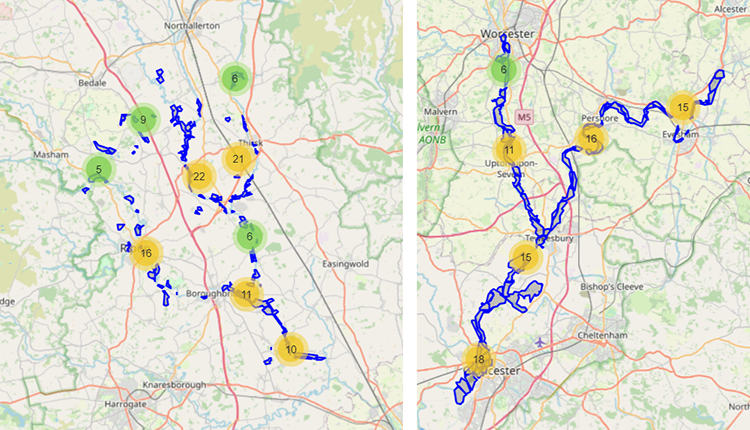Since we last wrote a blog about this topic, we have continued to work closely with Fjordr to progress the work on historic floodplain land use. We have revamped our website and provided a range of information and resources about understanding the historic extent of floodplain meadows.
We now have an historic floodplain meadow map which shows the extent of floodplain meadows identified from tithe maps and early 19th C digitised maps, along with an assessment of whether they were noted in the Domesday book. However, the map only covers the areas we or others have secured funding to explore. We think we can assume that the extent of floodplain meadows in non-researched catchments is likely to be equivalent across all lowland floodplains.
Catchments we have now have data for are the Thames, Stour (Dorset), Culm (Devon), Severn and Avon (Gloucestershire), Ure and Ouse (Yorkshire), and Eden (Cumbria). Some of the data were collected through projects not funded through the FMP and we are grateful to those who are happy to share these data.
On the Ure and Ouse, we have worked with Martin Hammond who has written a book about the floodplain meadows on the Ouse and has extensively researched their historic extent through archive research. We have used his data to compare to the method we are using with digital maps and found that the two different methods are able to tell us similar information. This gives us the reassurance that the use of easily available digital maps alongside interpretation of the landform and field names is yielding reliable data.
We have explored the digital Domesday data to understand the extent of meadows recorded there, and woven this into our historic web map. We are also about to put more catchments on the webmap, including work on the Windrush, and have plans to assess a catchment in Wales this year.
We are working on an academic publication to share the methods and findings across these different catchments and hope to have this available later in the spring.
 Extent of floodplain meadows mapped on the Ouse, Yorkshire (right) and the Severn and Avon, Gloucestershire (left)
Extent of floodplain meadows mapped on the Ouse, Yorkshire (right) and the Severn and Avon, Gloucestershire (left)
If you zoom in and select a particular meadow on the webmap, you can access all that is known from the maps about that site, why it is thought to be an old floodplain meadow and the level of confidence applied to the allocation.
The different catchments do appear to have evidence of floodplain meadows from modern landforms and old maps to different extents, likely to be largely dependent on the timing of enclosure. In Yorkshire, enclosure happened earlier than in Gloucestershire for example, and is likely to explain why there is now less evidence of historic floodplain meadows on the old maps in that area.
These data can be used to feed into current policy discussions on evidencing and allocating a designation of ancient grasslands and on helping to inform restoration activity. We also suggest that this sort of information could be used to inform the current development of Local Nature Recovery Strategies.
If you are planning to assess historic floodplain land use and would like to know more, please get in touch. If you have already carried out such an assessment and would like to share your findings, we would also love to hear from you.